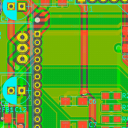
To debug things, it often helps to start at the lower level. Unfortunatley, these days we're a bit prone to the "libraritis disease". Libraries are fine to get things done, but they also add complexity and layers hard to see through when something does not work.
There is no need for any library at all to test basic GPIO functions!
There's the sysfs interface to gpio, built into the kernel. It's not complicated. To test if you can actually switch on a LED connected to GPIO0, you do:
See if GPIO0 is already made available (by another piece of software) for user space control:
ls /sys/class/gpio/gpio0
If you get "No such file or directory", then it is not yet available and you need to "export" it, see next step. Otherwise, you can skip the next step.
"Export", i.e. make GPIO0 available for controlling it from user space:
echo 0 >/sys/class/gpio/export
If you get an error here, some kernel level driver already claimed that pin for something, and neither you nor any user space library will be able to control it. In that case, you need to figure out what you have installed already that might want GPIO0 for itself. On a fresh Omega2, GPIO0 is available.
If you got so far, GPIO is available for direct control.
To make it an output:
echo "out" >/sys/class/gpio/gpio0/direction
To switch the output to high level (~3.3V):
echo 1 >/sys/class/gpio/gpio0/value
To switch it to low level (~0V):
echo 0 >/sys/class/gpio/gpio0/value
If your LED does not turn on and off this way, then you need to debug the wiring. No library can help before that works